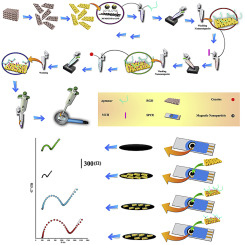当前位置:
X-MOL 学术
›
Anal. Chim. Acta
›
论文详情
Our official English website, www.x-mol.net, welcomes your
feedback! (Note: you will need to create a separate account there.)
Fabrication of a novel aptasensor based on three-dimensional reduced graphene oxide/polyaniline/gold nanoparticle composite as a novel platform for high sensitive and specific cocaine detection
Analytica Chimica Acta ( IF 5.7 ) Pub Date : 2017-12-01 , DOI: 10.1016/j.aca.2017.10.035 Pegah Hashemi , Hasan Bagheri , Abbas Afkhami , Yalda Hosseinzadeh Ardakani , Tayyebeh Madrakian
Analytica Chimica Acta ( IF 5.7 ) Pub Date : 2017-12-01 , DOI: 10.1016/j.aca.2017.10.035 Pegah Hashemi , Hasan Bagheri , Abbas Afkhami , Yalda Hosseinzadeh Ardakani , Tayyebeh Madrakian

|
In the present research, we have developed a novel label free aptasensor based on screen printed carbon electrode (SPCE) modified with three-dimensional magnetic reduced graphene oxide(3D-MRGO)/polyaniline(PA)/gold nanoparticle(AuNP) nanocomposite for impedimetric determination of cocaine. To achieve this goal, a specific thiolated cocaine aptamer was immobilized onto the surface of synthesized nanocomposite. The signaling mechanism of the proposed aptasensor was based on increase in the [Fe(CN)6]3-/4- charge transfer resistance (RCT) as an electrochemical probe in the presence of target analyte. In order to collect of 3D-MRGO/PA/AuNP/aptamer on the surface of working electrode easily, a new electrochemical cell was fabricated. The advantages of the new electrochemical cell configuration can be counted as reusing SPCE for several times, obtaining repeatable responses, reducing required volume of electrolyte and probe solution and making proposed method more user-friendly. Cyclic voltammetry (CV), electrochemical impedance spectroscopy (EIS), scanning electron microscopy (SEM) and Fourier transform infrared spectroscopy (FT-IR) were used for the characterization of synthesized nanocomposite and modified electrode surface. Under optimized condition, cocaine was determined in a linear concentration range from 0.09 to 85 nM with a detection limit of 0.029 nM by EIS. Also, in order to test applicability of the proposed aptasensor, it was applied to determine cocaine in urine and serum samples and satisfactory results were obtained.
中文翻译:

基于三维还原氧化石墨烯/聚苯胺/金纳米颗粒复合物的新型适体传感器的制备作为高灵敏度和特异性可卡因检测的新型平台
在目前的研究中,我们开发了一种基于丝网印刷碳电极 (SPCE) 的新型无标记适体传感器,该电极采用三维磁性还原氧化石墨烯 (3D-MRGO)/聚苯胺 (PA)/金纳米颗粒 (AuNP) 纳米复合材料进行阻抗测量。可卡因的测定。为了实现这一目标,一种特定的硫醇化可卡因适体被固定在合成纳米复合材料的表面上。所提出的适体传感器的信号机制是基于 [Fe(CN)6]3-/4- 电荷转移电阻 (RCT) 作为电化学探针在目标分析物存在下的增加。为了方便地在工作电极表面收集 3D-MRGO/PA/AuNP/适配体,制备了一种新的电化学电池。新的电化学电池配置的优势可以算作多次重复使用SPCE,获得可重复的响应,减少所需的电解质和探针溶液体积,并使所提出的方法对用户更加友好。循环伏安法 (CV)、电化学阻抗谱 (EIS)、扫描电子显微镜 (SEM) 和傅里叶变换红外光谱 (FT-IR) 用于表征合成的纳米复合材料和改性电极表面。在优化条件下,可卡因的线性浓度范围为 0.09 至 85 nM,EIS 检测限为 0.029 nM。此外,为了测试所提出的适体传感器的适用性,将其应用于测定尿液和血清样品中的可卡因,并获得了令人满意的结果。电化学阻抗谱 (EIS)、扫描电子显微镜 (SEM) 和傅里叶变换红外光谱 (FT-IR) 用于表征合成的纳米复合材料和改性电极表面。在优化条件下,可卡因的线性浓度范围为 0.09 至 85 nM,EIS 检测限为 0.029 nM。此外,为了测试所提出的适体传感器的适用性,将其应用于测定尿液和血清样品中的可卡因,并获得了令人满意的结果。电化学阻抗谱 (EIS)、扫描电子显微镜 (SEM) 和傅里叶变换红外光谱 (FT-IR) 用于表征合成的纳米复合材料和改性电极表面。在优化条件下,可卡因的线性浓度范围为 0.09 至 85 nM,EIS 检测限为 0.029 nM。此外,为了测试所提出的适体传感器的适用性,将其应用于测定尿液和血清样品中的可卡因,并获得了令人满意的结果。09 至 85 nM,EIS 检测限为 0.029 nM。此外,为了测试所提出的适体传感器的适用性,将其应用于测定尿液和血清样品中的可卡因,并获得了令人满意的结果。09 至 85 nM,EIS 检测限为 0.029 nM。此外,为了测试所提出的适体传感器的适用性,将其应用于测定尿液和血清样品中的可卡因,并获得了令人满意的结果。
更新日期:2017-12-01
中文翻译:

基于三维还原氧化石墨烯/聚苯胺/金纳米颗粒复合物的新型适体传感器的制备作为高灵敏度和特异性可卡因检测的新型平台
在目前的研究中,我们开发了一种基于丝网印刷碳电极 (SPCE) 的新型无标记适体传感器,该电极采用三维磁性还原氧化石墨烯 (3D-MRGO)/聚苯胺 (PA)/金纳米颗粒 (AuNP) 纳米复合材料进行阻抗测量。可卡因的测定。为了实现这一目标,一种特定的硫醇化可卡因适体被固定在合成纳米复合材料的表面上。所提出的适体传感器的信号机制是基于 [Fe(CN)6]3-/4- 电荷转移电阻 (RCT) 作为电化学探针在目标分析物存在下的增加。为了方便地在工作电极表面收集 3D-MRGO/PA/AuNP/适配体,制备了一种新的电化学电池。新的电化学电池配置的优势可以算作多次重复使用SPCE,获得可重复的响应,减少所需的电解质和探针溶液体积,并使所提出的方法对用户更加友好。循环伏安法 (CV)、电化学阻抗谱 (EIS)、扫描电子显微镜 (SEM) 和傅里叶变换红外光谱 (FT-IR) 用于表征合成的纳米复合材料和改性电极表面。在优化条件下,可卡因的线性浓度范围为 0.09 至 85 nM,EIS 检测限为 0.029 nM。此外,为了测试所提出的适体传感器的适用性,将其应用于测定尿液和血清样品中的可卡因,并获得了令人满意的结果。电化学阻抗谱 (EIS)、扫描电子显微镜 (SEM) 和傅里叶变换红外光谱 (FT-IR) 用于表征合成的纳米复合材料和改性电极表面。在优化条件下,可卡因的线性浓度范围为 0.09 至 85 nM,EIS 检测限为 0.029 nM。此外,为了测试所提出的适体传感器的适用性,将其应用于测定尿液和血清样品中的可卡因,并获得了令人满意的结果。电化学阻抗谱 (EIS)、扫描电子显微镜 (SEM) 和傅里叶变换红外光谱 (FT-IR) 用于表征合成的纳米复合材料和改性电极表面。在优化条件下,可卡因的线性浓度范围为 0.09 至 85 nM,EIS 检测限为 0.029 nM。此外,为了测试所提出的适体传感器的适用性,将其应用于测定尿液和血清样品中的可卡因,并获得了令人满意的结果。09 至 85 nM,EIS 检测限为 0.029 nM。此外,为了测试所提出的适体传感器的适用性,将其应用于测定尿液和血清样品中的可卡因,并获得了令人满意的结果。09 至 85 nM,EIS 检测限为 0.029 nM。此外,为了测试所提出的适体传感器的适用性,将其应用于测定尿液和血清样品中的可卡因,并获得了令人满意的结果。









































 京公网安备 11010802027423号
京公网安备 11010802027423号